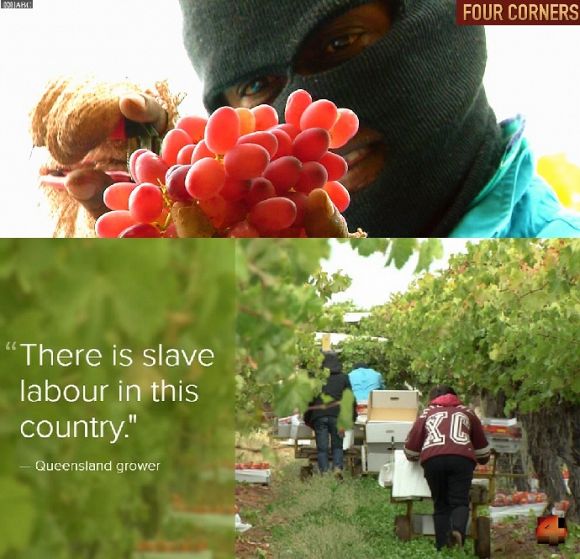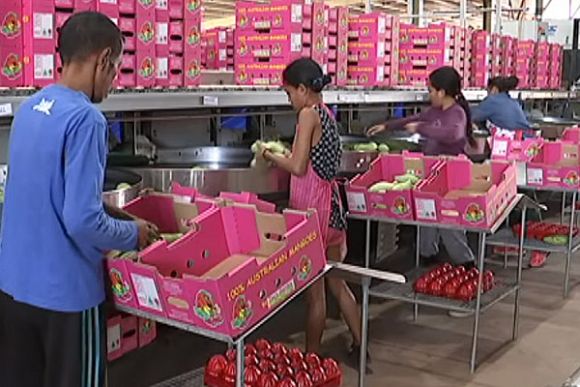After decades of resistance to the charms of the farm lobby, the Morrison Government is now committed to introducing a dedicated Agriculture Visa from the end of September 2021.
Details are not yet available but we can be certain the farm lobby will have convinced Agriculture Minister David Littleproud that very few worker protections are needed.
A highly “streamlined visa” is critical if the Government and National Farmers Federation (NFF) are to convince farmers to use it rather than continuing to rely on the biggest labour trafficking scam and abuse of our asylum system in Australia’s history.
A scam so big, Littleproud has, unsuccessfully, called for an immigration amnesty for these workers.
Foreign Minister Marise Payne, whose department will be running the new Agriculture Visa, seems similarly convinced few protections will be needed, arguing that the two existing small farmworker visas have been a success. She makes no mention of at least 22 workers who have to date died on these visas or the appalling experience of “temporary” migrant farmworkers around the world.
For example, 1,500 migrant farmworkers have died in Italy over the past six years due to shocking treatment. Only 22 deaths compared to 1,500 may be viewed by Payne as a success.
According to a British Medical Journal article, Italy’s hospitals are receiving 43 outpatient consultations per day due to work injuries to migrant farmworkers.
The migrant farmworker system in Italy is run by modern slave masters called the “Caporali” — a particularly nasty form of labour-hire company.
In Italy, migrant farmworkers earn between €2-4 (AU$3.23-$6.46) per hour compared to the legal minimum of €7 (AU$11.31) per hour.
But many earn even less as they are paid according to the amount of fruit or vegetables they collect rather than the time spent at work. Sometimes, they are paid only €12 (AU$19.37) for eight hours’ work under the threat of the Caporali.
Note that the NFF insists farm workers in Australia must also be paid “piece rates” rather than a minimum hourly rate.
At the paltry wages they earn in Italy, it is hardly surprising migrant farmworkers often live in what are described as “Ghetti”.
These are shantytowns without water or proper standards of hygiene, sanitation or health services. Italy has an estimated 50-70 of these settlements, accounting for around 100,000 low wage migrant workers.
The NFF knows that to supply cheap and easily exploitable farm labour, it must keep Australians away from applying for such jobs and to convince governments that Australians don’t want to do such jobs — the reality is that Australians would do these jobs if they were properly paid and treated.
It would also require dealing with the behaviour of Australia’s supermarket duopoly.
If they had a choice, most Australian farmers would want to pay their workers the legal minimum hourly wage.
That is made impossible by the big supermarkets and the power they have over commercial media outlets due to the volume of their advertising spend.
No commercial media outlet would ever want to offend Woolworths or Coles and no political party would want to offend commercial media outlets.
So the exploitation of migrant farmworkers must go on — but it is by no means confined to Italy or Australia.
Prominent German magazine Der Spiegel describes migrant farmworkers in Germany as ‘cheap, expendable and imperilled’.
It says these workers are being tricked into believing they will get good wages and conditions. The reality is that they are paid on performance levels few humans could achieve or endure.
Moreover, various “costs”, usually unforeseen by the migrant worker, get taken out of their meagre wages by unscrupulous employers or labour-hire.
In Spain, migrant farmworkers are described as living in a ‘plastic sea’ of rubbish with no electricity, sanitation or running water.
Over 20 years ago, the UK Government announced a clampdown on “gangmasters” exploiting migrant farmworkers.
I spoke with my UK counterparts around this time and came to the conclusion it would be almost impossible to protect low skill migrant farmworkers from the predatory behaviour of these “gangmasters”.
Even after Brexit, little has changed for migrant farmworkers in the UK.
The Global Slavery Index says that migrant farmworkers using Canada’s Seasonal Agricultural Worker Program (which started in 1974) are ‘particularly vulnerable to exploitation as they are dependent on their employers for accommodation, food and employment, and often work and live in isolated rural areas’.
As in many other countries, they face language barriers that mean they may ‘sign work contracts they do not understand and are charged illegal recruitment fees in their home countries, leaving them under pressure of paying off significant debt’.
The University of Toronto reports that migrant farmworkers in Canada are:
‘Working up to 14 hour days on little pay and unliveable conditions and are forced to work while sick or injured, many complaints have been brought forward, with little to no change. Many workers have reported pest infestations and sewage leaks, beatings, harassment, and sexual violence. Furthermore, many are denied medical attention for serious health issues...’
And things are little different across the “ditch”. Migrant farmworker exploitation in New Zealand is said to be ‘rampant’.
In 2020, the New Zealand Government announced a $50 million program to tackle temporary migrant worker exploitation.
As in many other places, the problem is so entrenched that $50 million is likely to make little difference.
The centre of migrant farmworker exploitation is, of course, the USA, where the tradition of slaves picking cotton has never really died out.
Knowing the overseas experience, Australia for decades avoided the adoption of a dedicated Agriculture Visa — it would, after all, change the character of our nation forever.
But if we are to have a dedicated Agriculture Visa, we should at least try to make sure we put in the strongest possible worker protections.
That I fear will be impossible given the demands and power of the NFF and the hold they have over the National Party.
While the Government has announced a minor strengthening of laws to protect migrant workers, these proposed changes are little more than window dressing with no additional resources for enforcement.
Department of Home Affairs’ compliance activity against employers using undocumented labour has plunged over recent years even though the number of such employers and workers on farms has boomed.
The Government’s proposed legislative changes to protect migrant workers, which unsurprisingly no employer body has objected to, are a bit like taking a pea shooter to a nuclear war.
Get ready for regular media reports of appalling examples of exploitation and abuse as well as dodgy labour-hire companies screwing every possible cent out of migrant farmworkers.
How long before we see reports of “shanty towns” housing migrant farmworkers that are common in other countries?
We may initially worry about those reports — that is until migrant farmworker exploitation becomes so common no one cares anymore.
Dr Abul Rizvi is an Independent Australia columnist and a former Deputy Secretary of the Department of Immigration. You can follow Abul on Twitter @RizviAbul.
Related Articles
- Morrison Government yet to deal with massive asylum seeker and visa backlog
- Immigration not to blame for sluggish wages growth
- Federal Government's 'Intergenerational Report' based on a fallacy
- Grattan Institute's first report on skilled permanent migration like the curate's egg
- No opposition to post-COVID mass migration plan
 This work is licensed under a Creative Commons Attribution-NonCommercial-NoDerivs 3.0 Australia License
This work is licensed under a Creative Commons Attribution-NonCommercial-NoDerivs 3.0 Australia License
Support independent journalism Subscribe to IA.
















